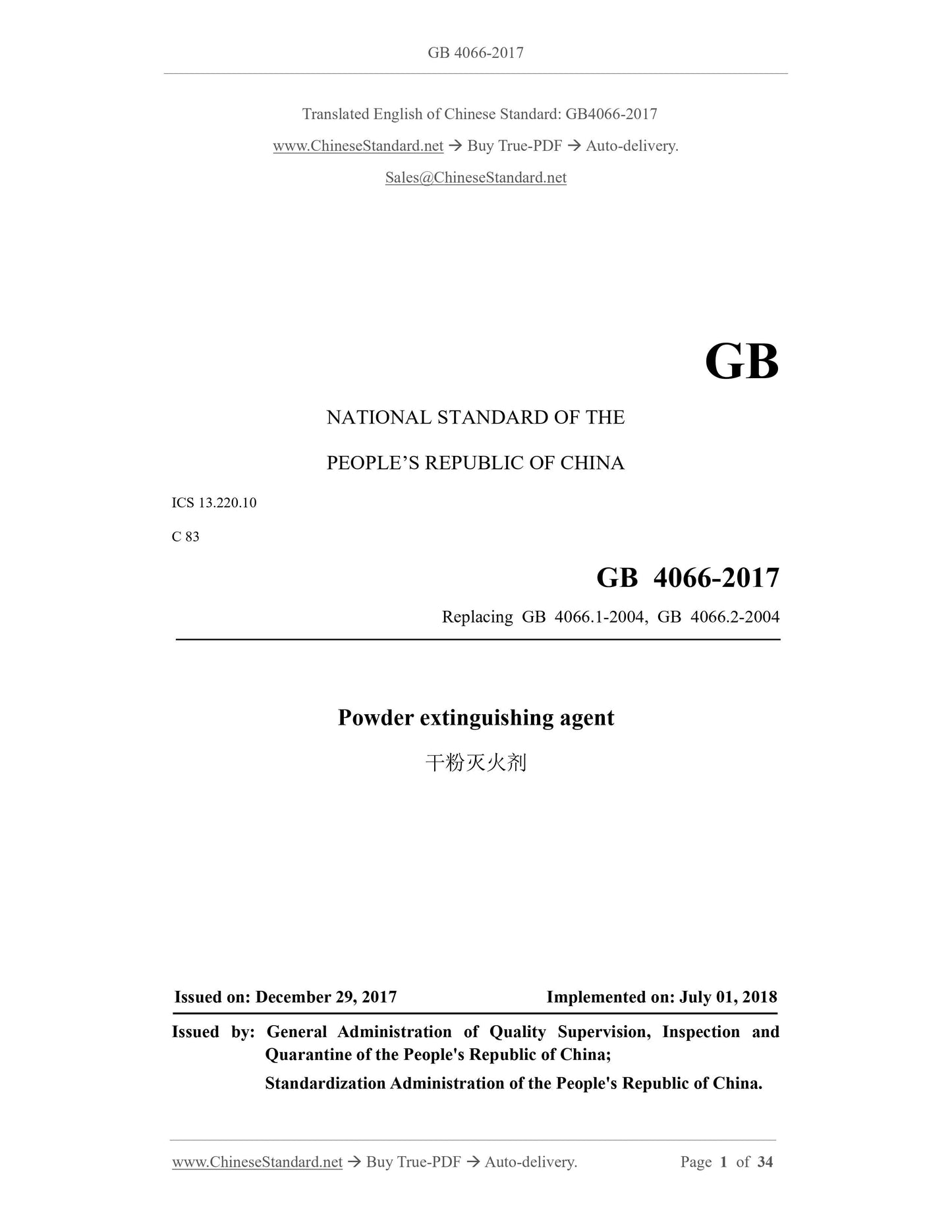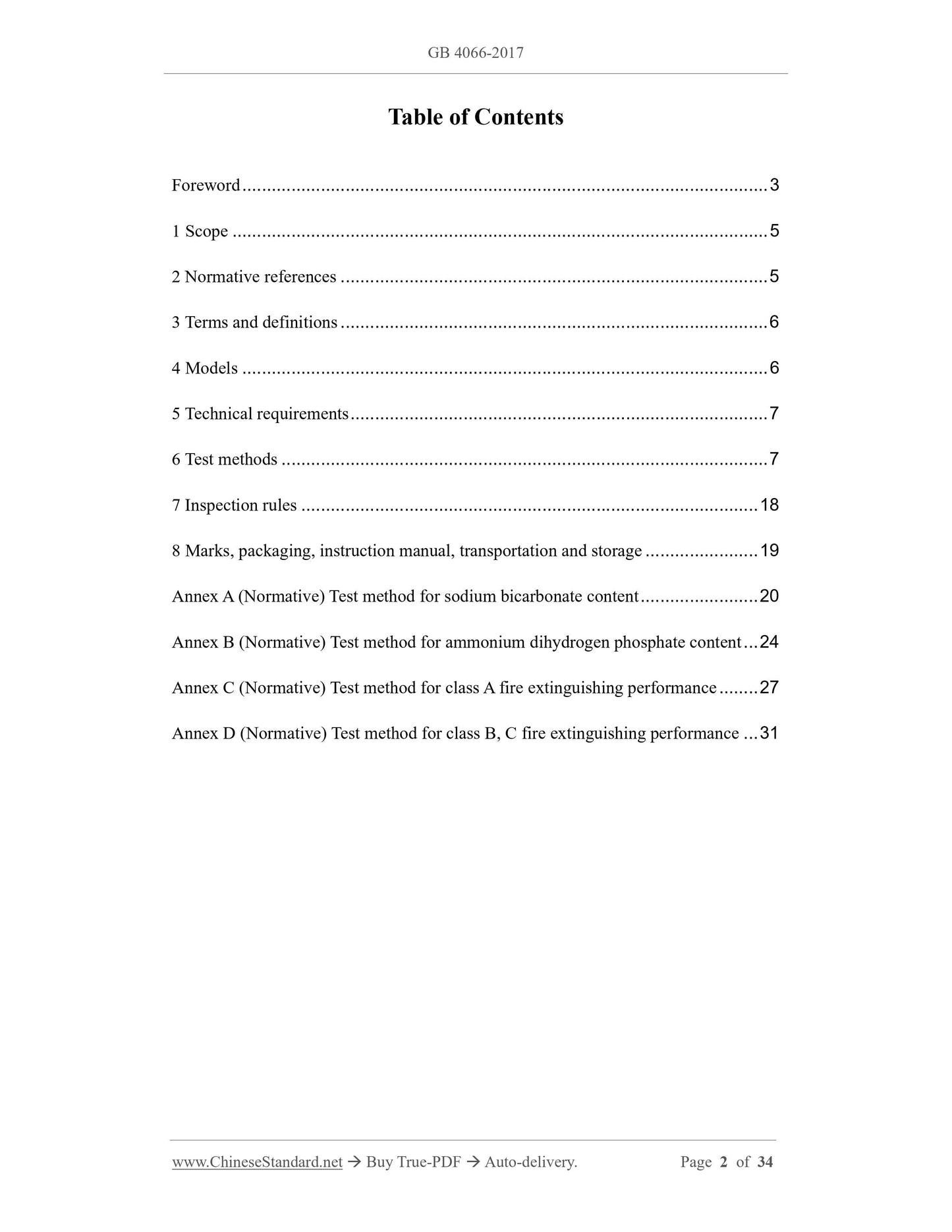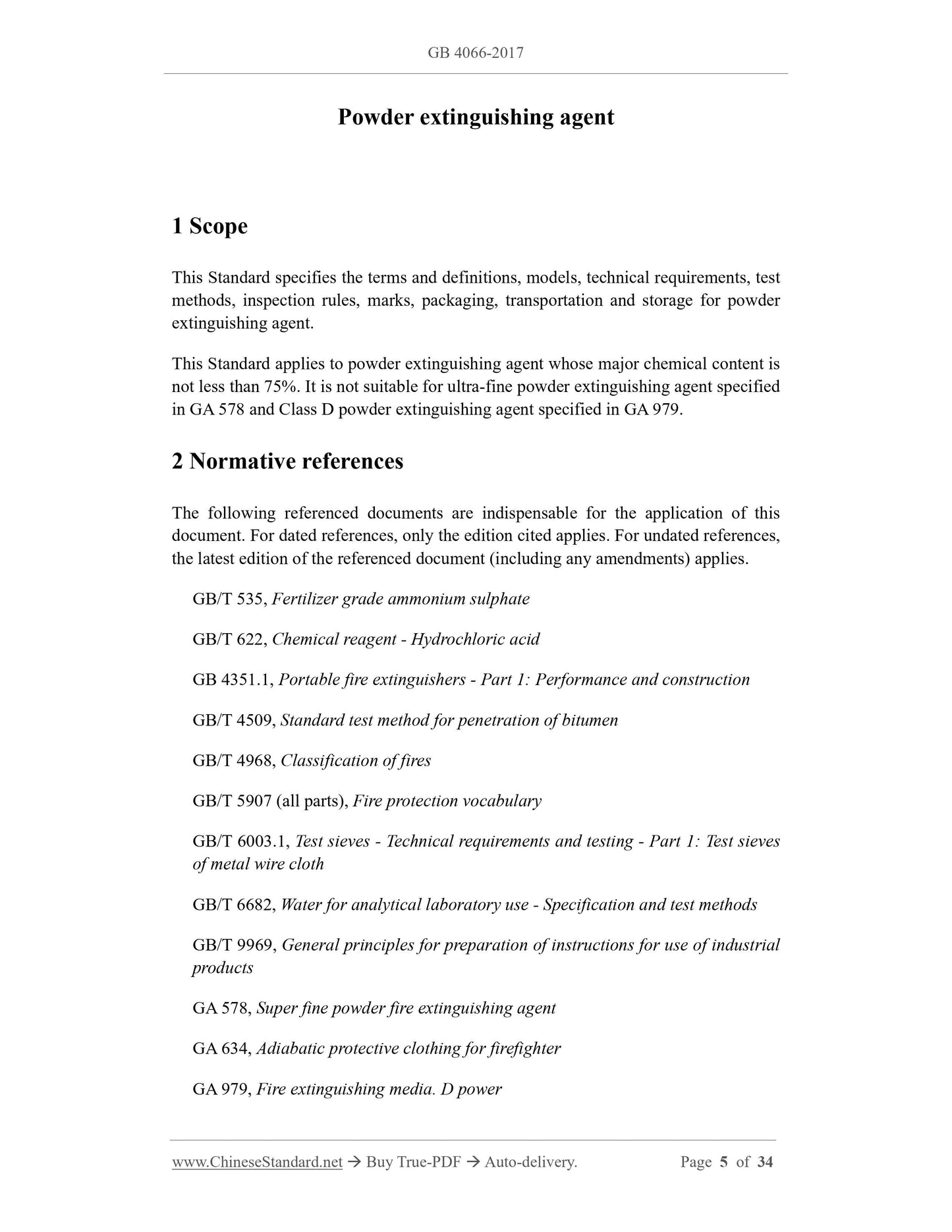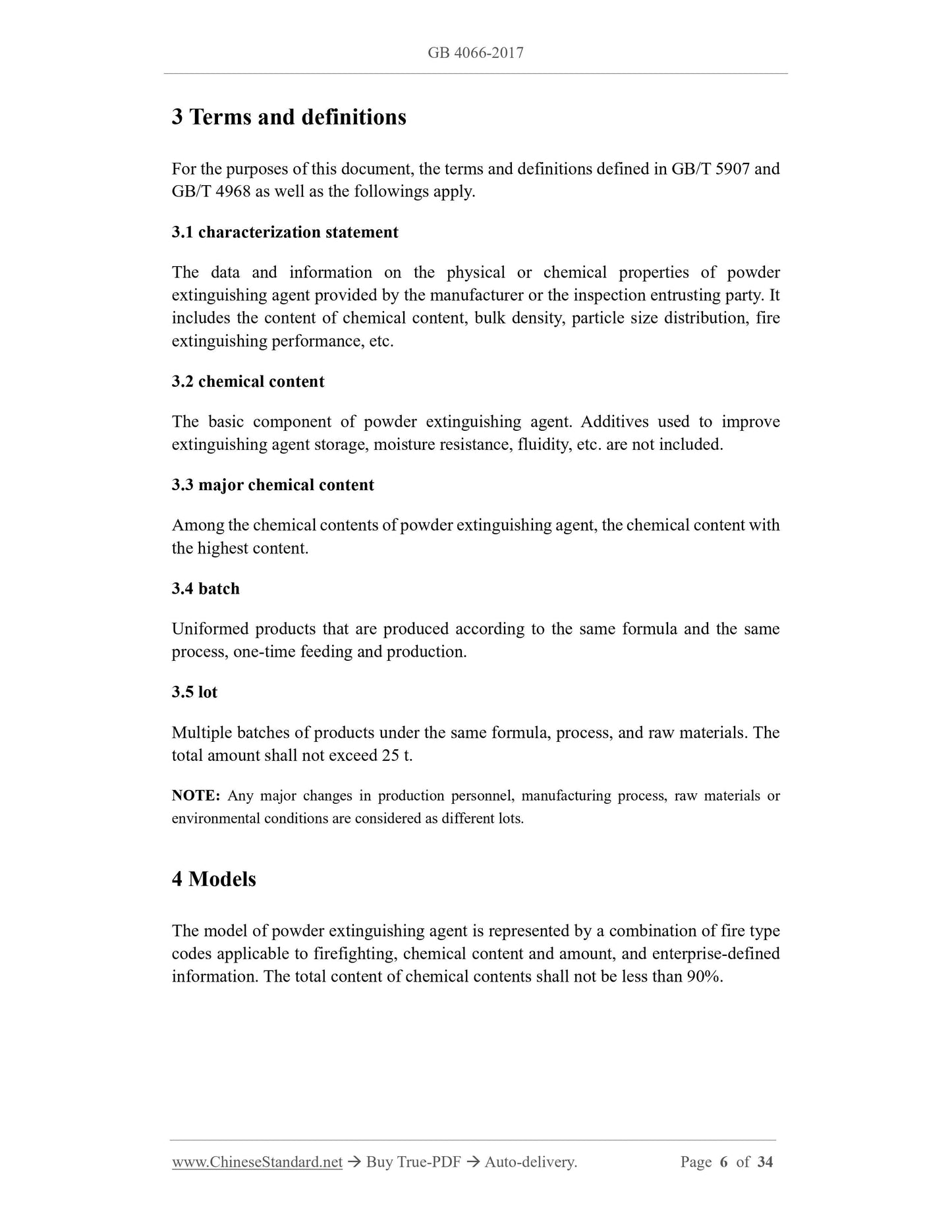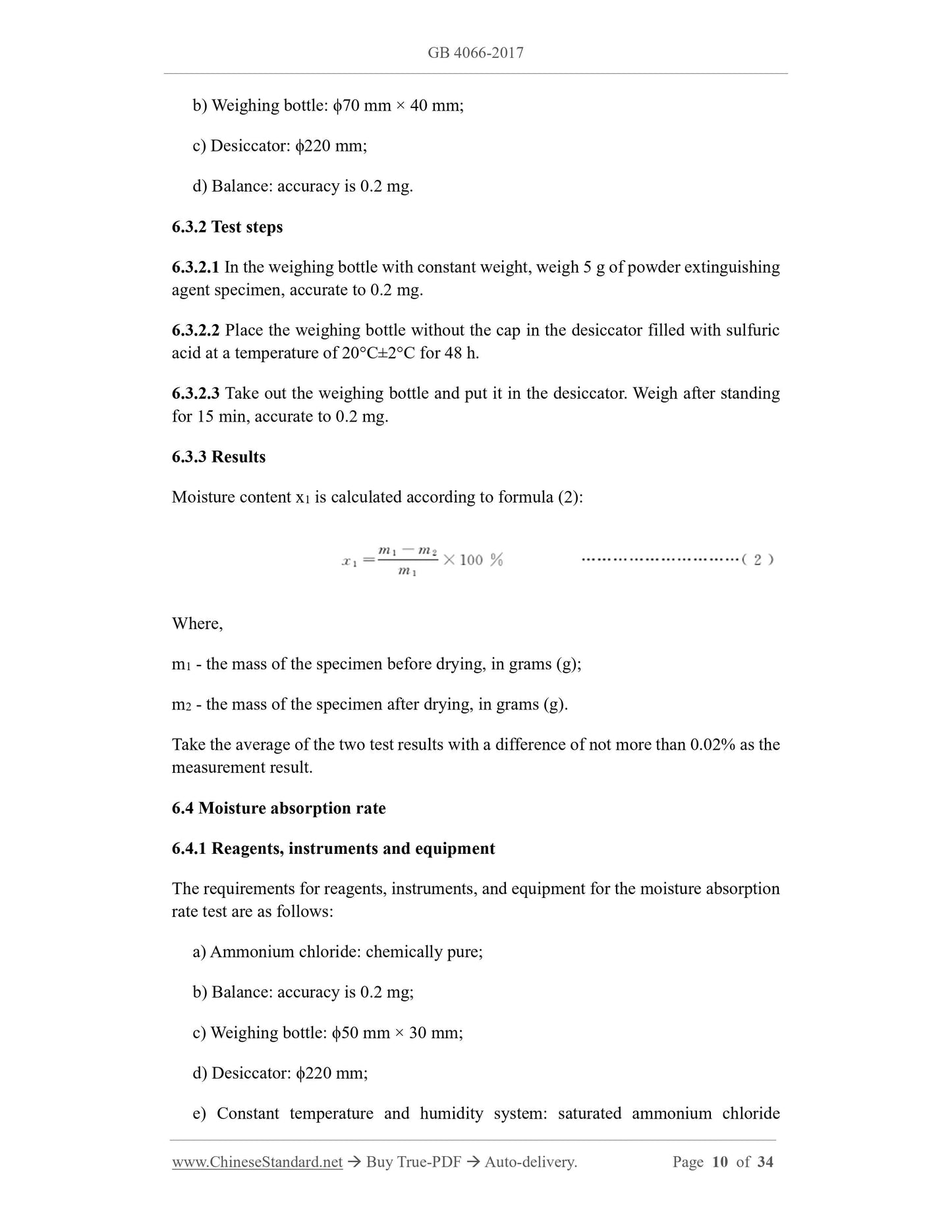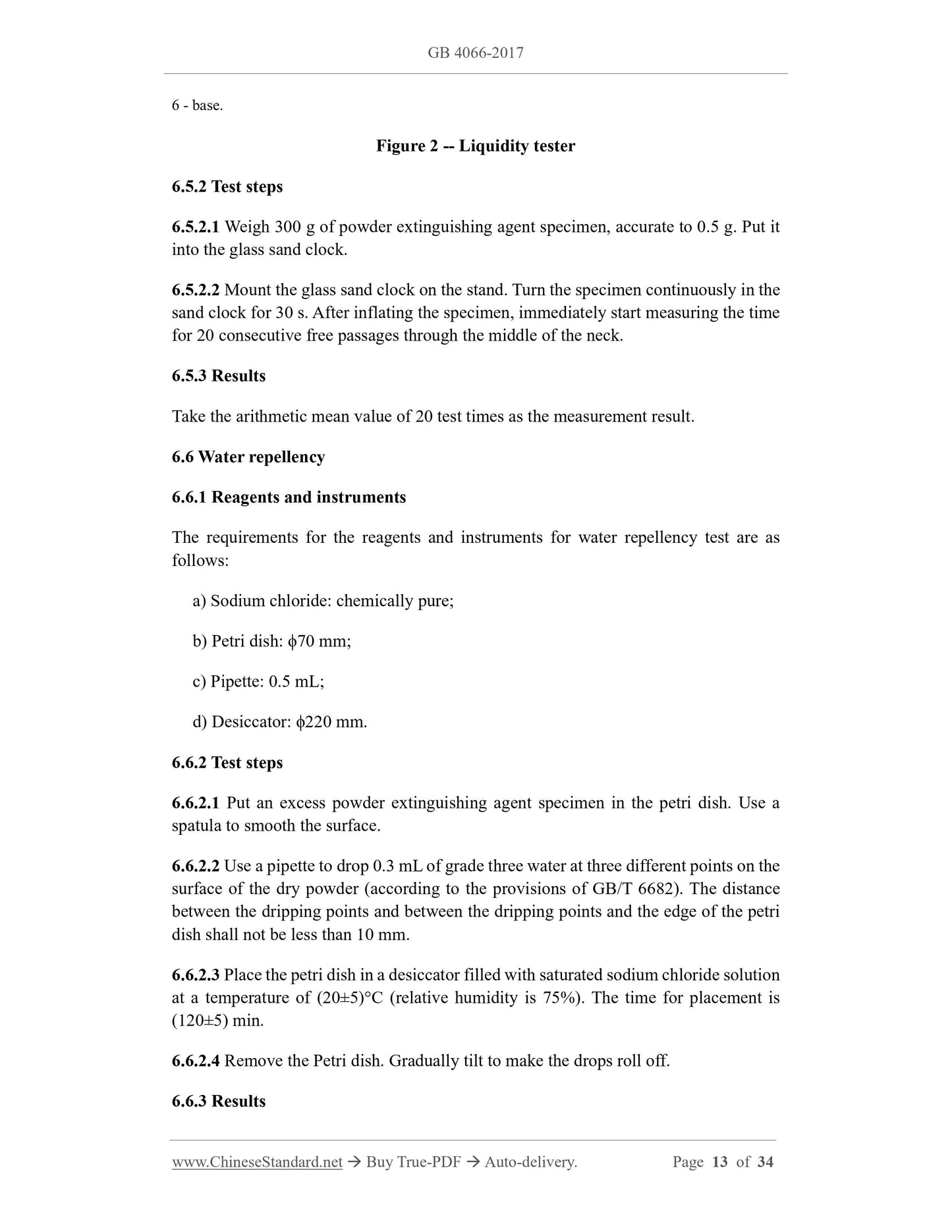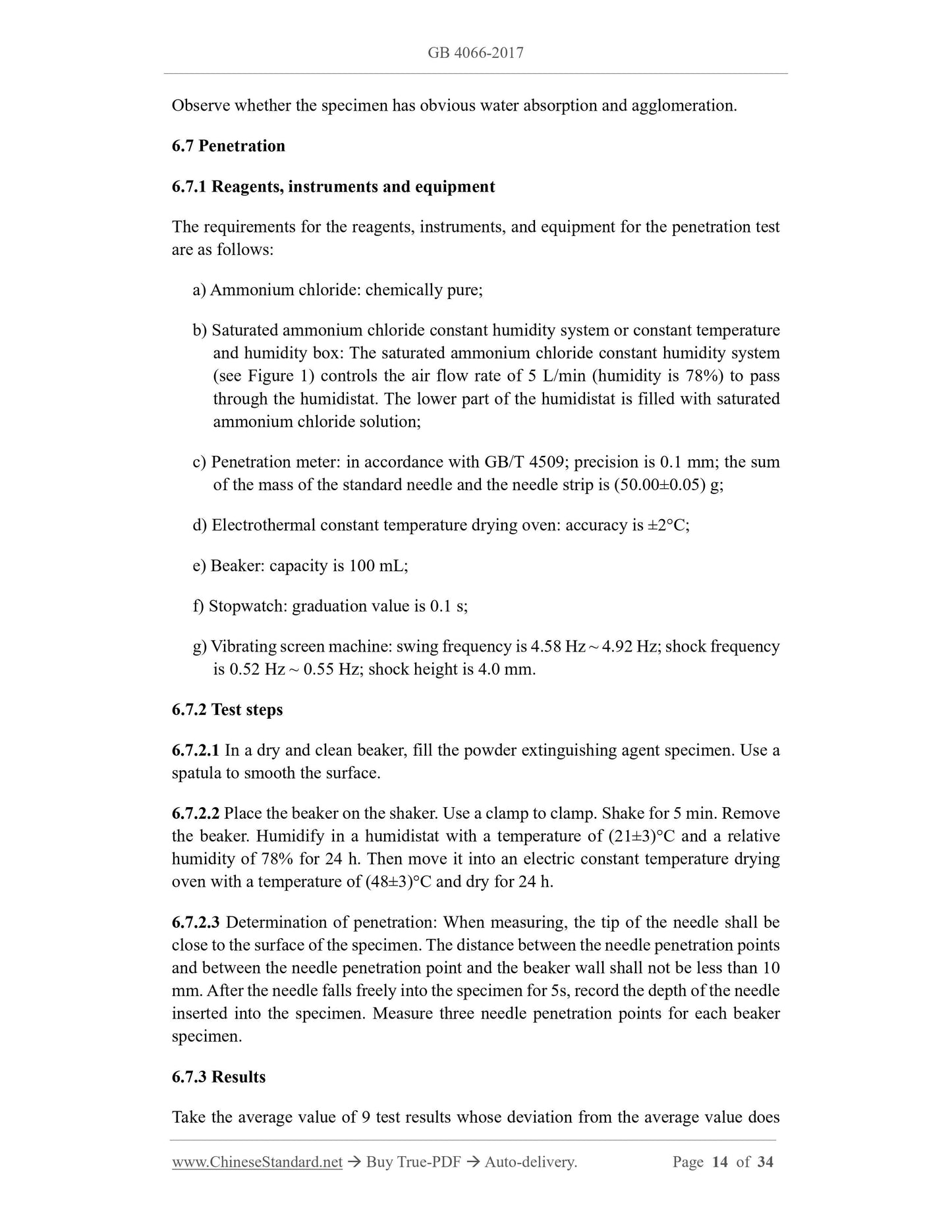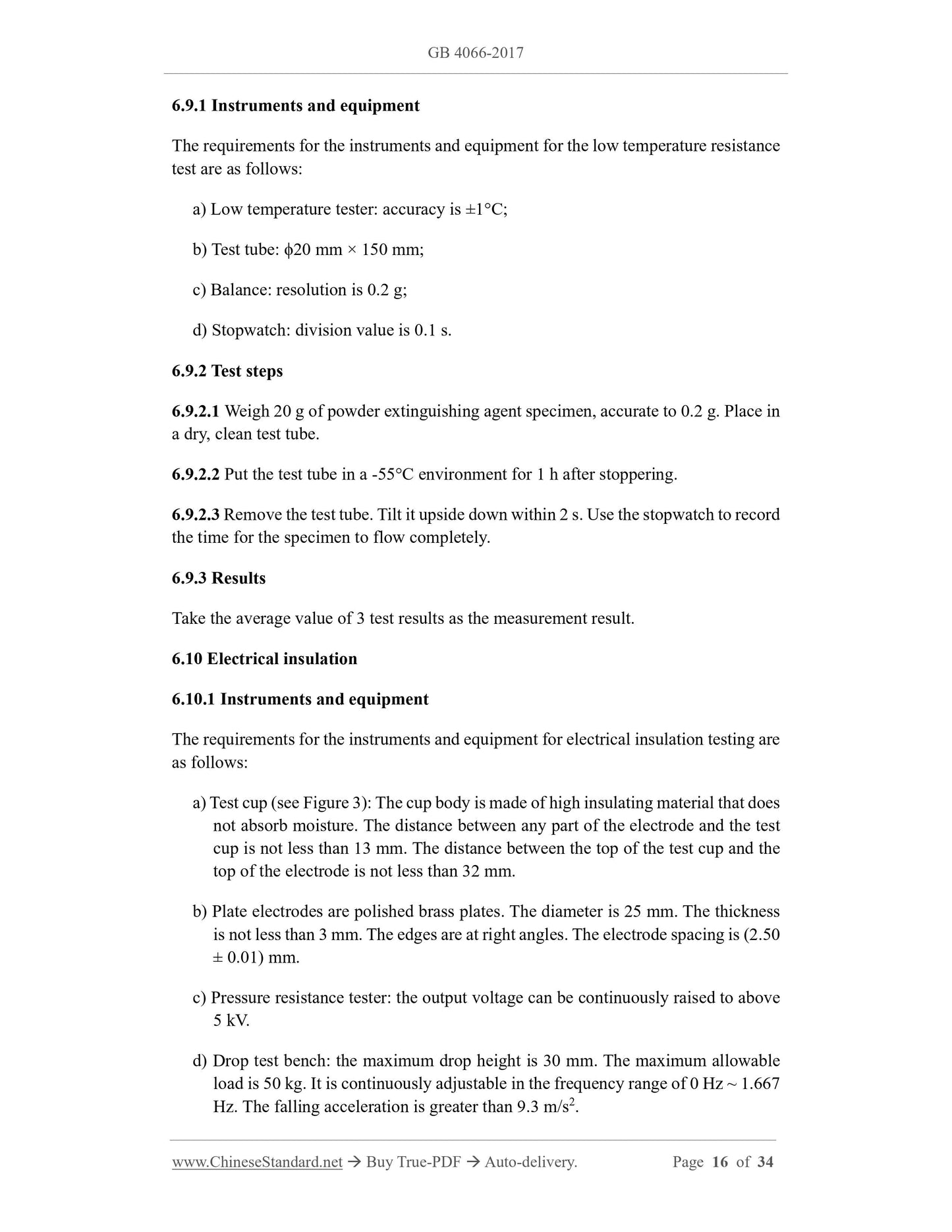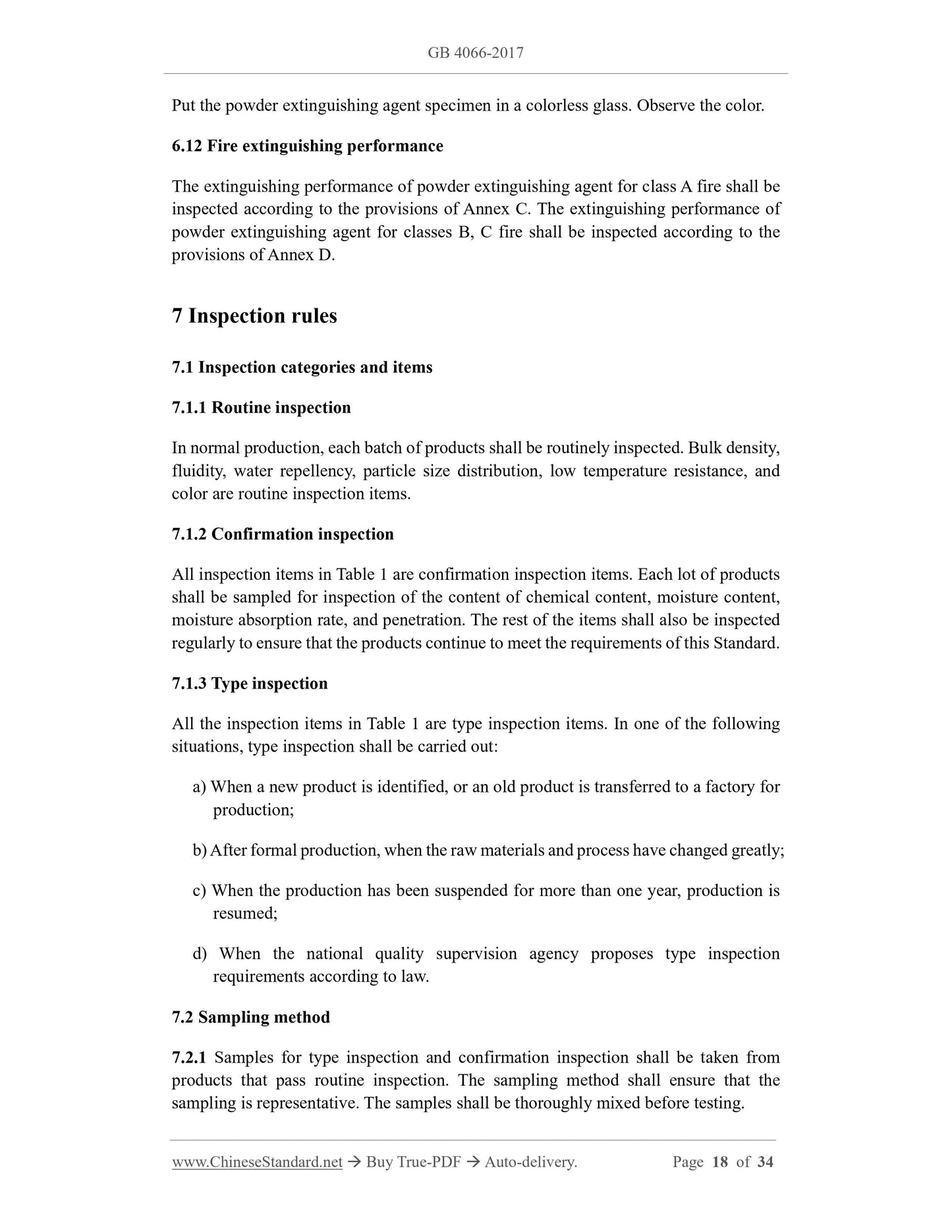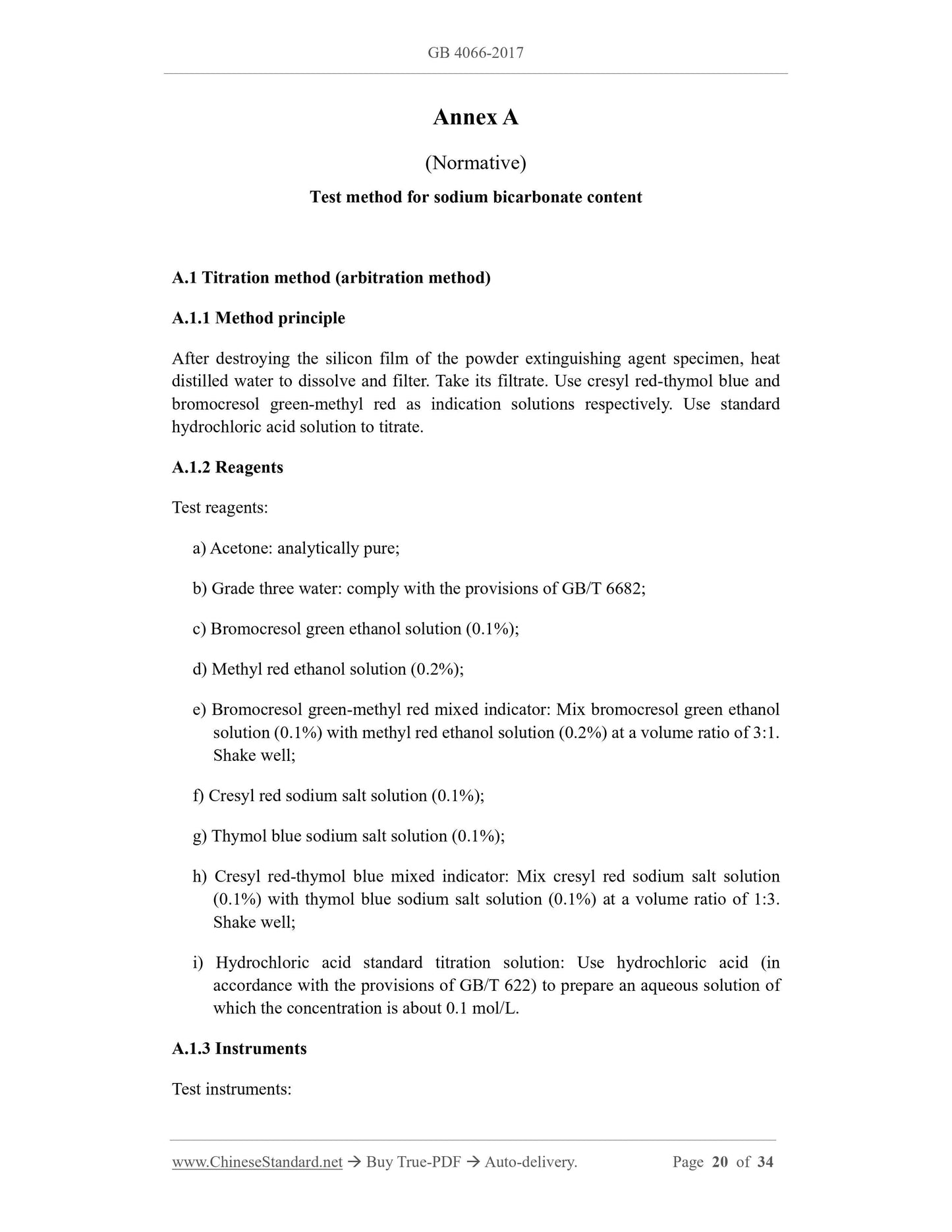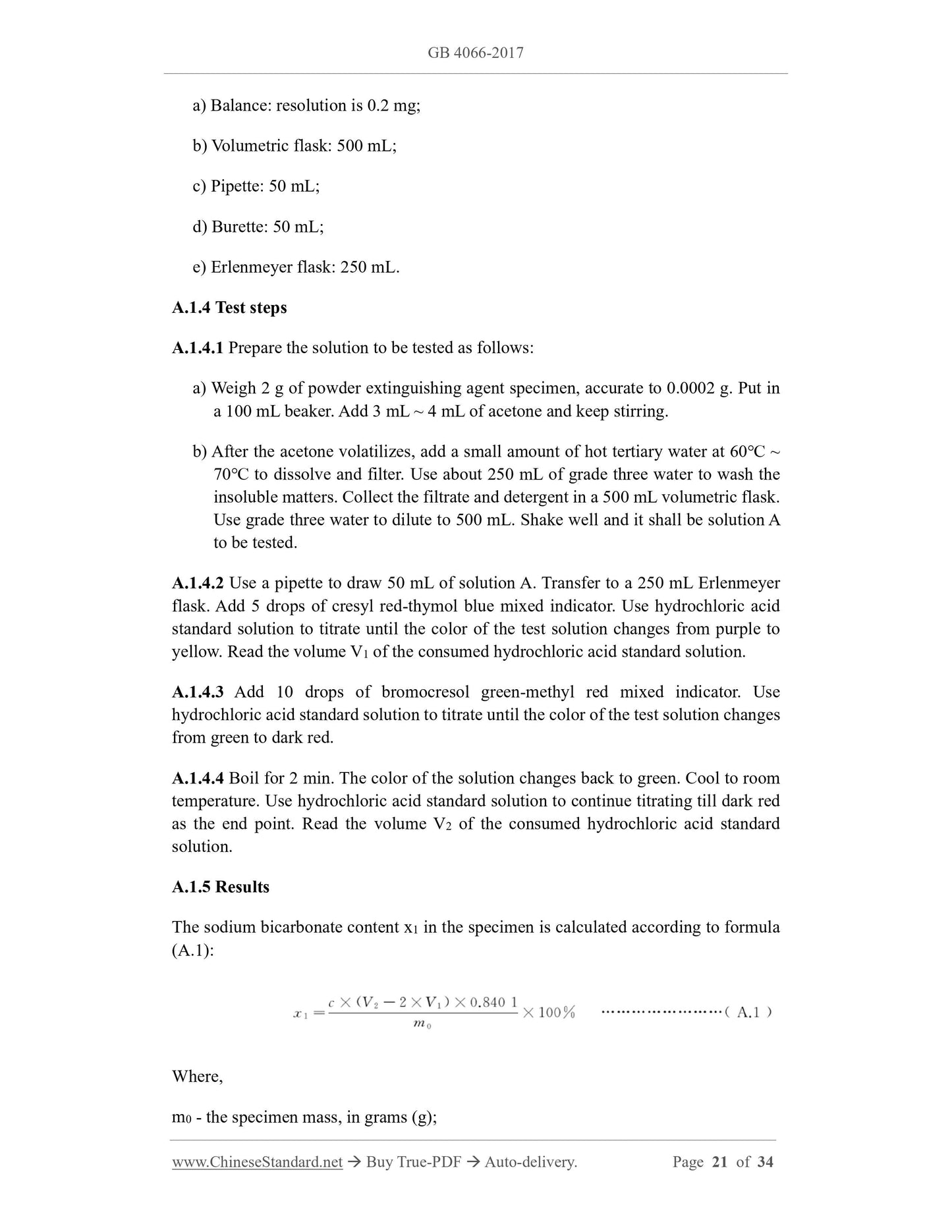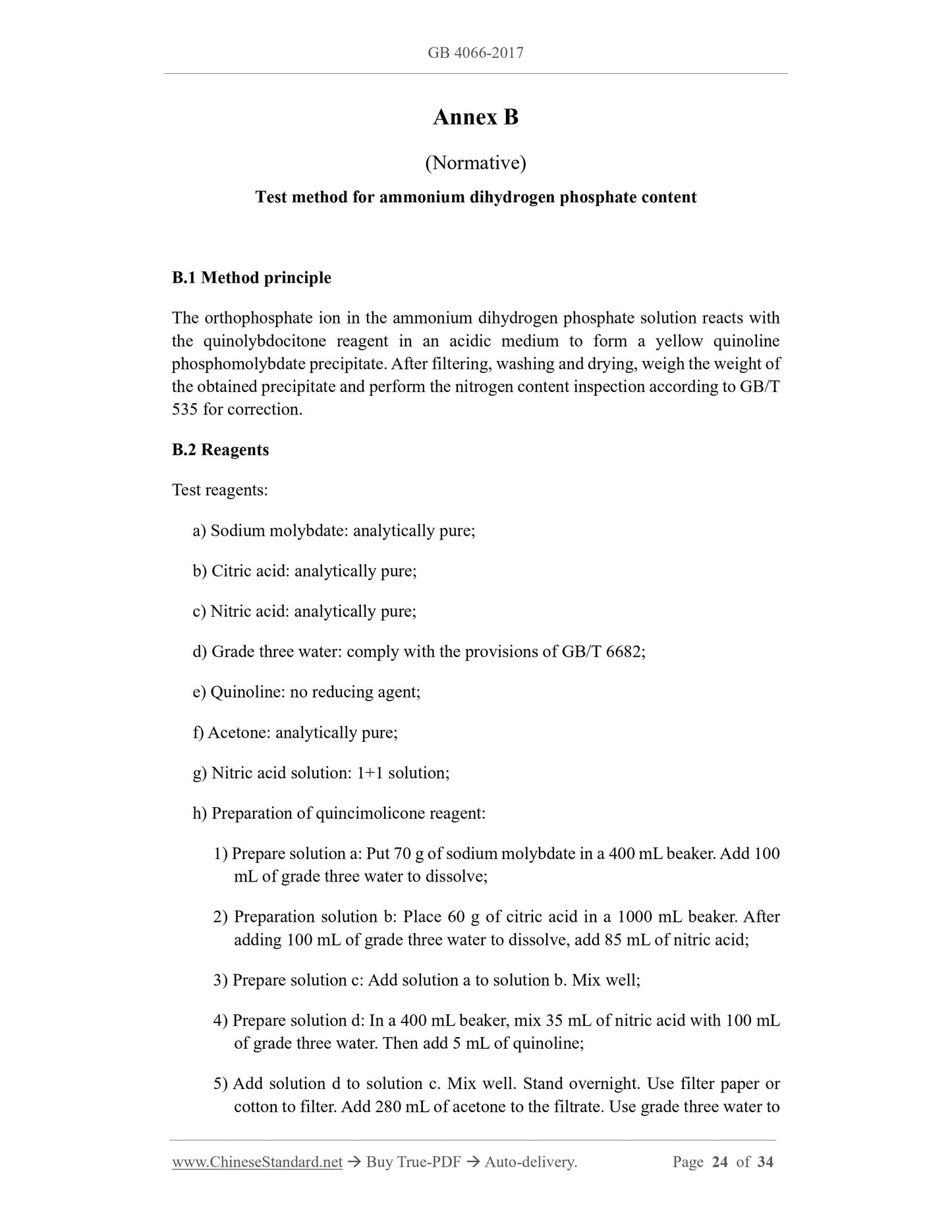1
/
von
12
PayPal, credit cards. Download editable-PDF & invoice in 1 second!
GB 4066-2017 English PDF (GB4066-2017)
GB 4066-2017 English PDF (GB4066-2017)
Normaler Preis
$350.00 USD
Normaler Preis
Verkaufspreis
$350.00 USD
Grundpreis
/
pro
Versand wird beim Checkout berechnet
Verfügbarkeit für Abholungen konnte nicht geladen werden
Delivery: 3 seconds. Download true-PDF + Invoice.
Get QUOTATION in 1-minute: Click GB 4066-2017
Historical versions: GB 4066-2017
Preview True-PDF (Reload/Scroll if blank)
GB 4066-2017: Powder extinguishing agent
GB 4066-2017
GB
NATIONAL STANDARD OF THE
PEOPLE’S REPUBLIC OF CHINA
ICS 13.220.10
C 83
Replacing GB 4066.1-2004, GB 4066.2-2004
Powder extinguishing agent
干粉灭火剂
ISSUED ON: DECEMBER 29, 2017
IMPLEMENTED ON: JULY 01, 2018
Issued by: General Administration of Quality Supervision, Inspection and
Quarantine of the People's Republic of China;
Standardization Administration of the People's Republic of China.
Table of Contents
Foreword ... 3
1 Scope ... 5
2 Normative references ... 5
3 Terms and definitions ... 6
4 Models ... 6
5 Technical requirements ... 7
6 Test methods ... 7
7 Inspection rules ... 18
8 Marks, packaging, instruction manual, transportation and storage ... 19
Annex A (Normative) Test method for sodium bicarbonate content ... 20
Annex B (Normative) Test method for ammonium dihydrogen phosphate content ... 24
Annex C (Normative) Test method for class A fire extinguishing performance ... 27
Annex D (Normative) Test method for class B, C fire extinguishing performance ... 31
Powder extinguishing agent
1 Scope
This Standard specifies the terms and definitions, models, technical requirements, test
methods, inspection rules, marks, packaging, transportation and storage for powder
extinguishing agent.
This Standard applies to powder extinguishing agent whose major chemical content is
not less than 75%. It is not suitable for ultra-fine powder extinguishing agent specified
in GA 578 and Class D powder extinguishing agent specified in GA 979.
2 Normative references
The following referenced documents are indispensable for the application of this
document. For dated references, only the edition cited applies. For undated references,
the latest edition of the referenced document (including any amendments) applies.
GB/T 535, Fertilizer grade ammonium sulphate
GB/T 622, Chemical reagent - Hydrochloric acid
GB 4351.1, Portable fire extinguishers - Part 1: Performance and construction
GB/T 4509, Standard test method for penetration of bitumen
GB/T 4968, Classification of fires
GB/T 5907 (all parts), Fire protection vocabulary
GB/T 6003.1, Test sieves - Technical requirements and testing - Part 1: Test sieves
of metal wire cloth
GB/T 6682, Water for analytical laboratory use - Specification and test methods
GB/T 9969, General principles for preparation of instructions for use of industrial
products
GA 578, Super fine powder fire extinguishing agent
GA 634, Adiabatic protective clothing for firefighter
GA 979, Fire extinguishing media. D power
3 Terms and definitions
For the purposes of this document, the terms and definitions defined in GB/T 5907 and
GB/T 4968 as well as the followings apply.
3.1 characterization statement
The data and information on the physical or chemical properties of powder
extinguishing agent provided by the manufacturer or the inspection entrusting party. It
includes the content of chemical content, bulk density, particle size distribution, fire
extinguishing performance, etc.
3.2 chemical content
The basic component of powder extinguishing agent. Additives used to improve
extinguishing agent storage, moisture resistance, fluidity, etc. are not included.
3.3 major chemical content
Among the chemical contents of powder extinguishing agent, the chemical content with
the highest content.
3.4 batch
Uniformed products that are produced according to the same formula and the same
process, one-time feeding and production.
3.5 lot
Multiple batches of products under the same formula, process, and raw materials. The
total amount shall not exceed 25 t.
NOTE: Any major changes in production personnel, manufacturing process, raw materials or
environmental conditions are considered as different lots.
4 Models
The model of powder extinguishing agent is represented by a combination of fire type
codes applicable to firefighting, chemical content and amount, and enterprise-defined
information. The total content of chemical contents shall not be less than 90%.
b) Weighing bottle: ϕ70 mm × 40 mm;
c) Desiccator: ϕ220 mm;
d) Balance: accuracy is 0.2 mg.
6.3.2 Test steps
6.3.2.1 In the weighing bottle with constant weight, weigh 5 g of powder extinguishing
agent specimen, accurate to 0.2 mg.
6.3.2.2 Place the weighing bottle without the cap in the desiccator filled with sulfuric
acid at a temperature of 20°C±2°C for 48 h.
6.3.2.3 Take out the weighing bottle and put it in the desiccator. Weigh after standing
for 15 min, accurate to 0.2 mg.
6.3.3 Results
Moisture content x1 is calculated according to formula (2):
Where,
m1 - the mass of the specimen before drying, in grams (g);
m2 - the mass of the specimen after drying, in grams (g).
Take the average of the two test results with a difference of not more than 0.02% as the
measurement result.
6.4 Moisture absorption rate
6.4.1 Reagents, instruments and equipment
The requirements for reagents, instruments, and equipment for the moisture absorption
rate test are as follows:
a) Ammonium chloride: chemically pure;
b) Balance: accuracy is 0.2 mg;
c) Weighing bottle: ϕ50 mm × 30 mm;
d) Desiccator: ϕ220 mm;
e) Constant temperature and humidity system: saturated ammonium chloride
6 - base.
Figure 2 -- Liquidity tester
6.5.2 Test steps
6.5.2.1 Weigh 300 g of powder extinguishing agent specimen, accurate to 0.5 g. Put it
into the glass sand clock.
6.5.2.2 Mount the glass sand clock on the stand. Turn the specimen continuously in the
sand clock for 30 s. After inflating the specimen, immediately start measuring the time
for 20 consecutive free passages through the middle of the neck.
6.5.3 Results
Take the arithmetic mean value of 20 test times as the measurement result.
6.6 Water repellency
6.6.1 Reagents and instruments
The requirements for the reagents and instruments for water repellency test are as
follows:
a) Sodium chloride: chemically pure;
b) Petri dish: ϕ70 mm;
c) Pipette: 0.5 mL;
d) Desiccator: ϕ220 mm.
6.6.2 Test steps
6.6.2.1 Put an excess powder extinguishing agent specimen in the petri dish. Use a
spatula to smooth the surface.
6.6.2.2 Use a pipette to drop 0.3 mL of grade three water at three different points on the
surface of the dry powder (according to the provisions of GB/T 6682). The distance
between the dripping points and between the dripping points and the edge of the petri
dish shall not be less than 10 mm.
6.6.2.3 Place the petri dish in a desiccator filled with saturated sodium chloride solution
at a temperature of (20±5)°C (relative humidity is 75%). The time for placement is
(120±5) min.
6.6.2.4 Remove the Petri dish. Gradually tilt to make the drops roll off.
6.6.3 Results
Observe whether the specimen has obvious water absorption and agglomeration.
6.7 Penetration
6.7.1 Reagents, instruments and equipment
The requirements for the reagents, instruments, and equipment for the penetration test
are as follows:
a) Ammonium chloride: chemically pure;
b) Saturated ammonium chloride constant humidity system or constant temperature
and humidity box: The saturated ammonium chloride constant humidity system
(see Figure 1) controls the air flow rate of 5 L/min (humidity is 78%) to pass
through the humidistat. The lower part of the humidistat is filled with saturated
ammonium chloride solution;
c) Penetration meter: in accordance with GB/T 4509; precision is 0.1 mm; the sum
of...
Get QUOTATION in 1-minute: Click GB 4066-2017
Historical versions: GB 4066-2017
Preview True-PDF (Reload/Scroll if blank)
GB 4066-2017: Powder extinguishing agent
GB 4066-2017
GB
NATIONAL STANDARD OF THE
PEOPLE’S REPUBLIC OF CHINA
ICS 13.220.10
C 83
Replacing GB 4066.1-2004, GB 4066.2-2004
Powder extinguishing agent
干粉灭火剂
ISSUED ON: DECEMBER 29, 2017
IMPLEMENTED ON: JULY 01, 2018
Issued by: General Administration of Quality Supervision, Inspection and
Quarantine of the People's Republic of China;
Standardization Administration of the People's Republic of China.
Table of Contents
Foreword ... 3
1 Scope ... 5
2 Normative references ... 5
3 Terms and definitions ... 6
4 Models ... 6
5 Technical requirements ... 7
6 Test methods ... 7
7 Inspection rules ... 18
8 Marks, packaging, instruction manual, transportation and storage ... 19
Annex A (Normative) Test method for sodium bicarbonate content ... 20
Annex B (Normative) Test method for ammonium dihydrogen phosphate content ... 24
Annex C (Normative) Test method for class A fire extinguishing performance ... 27
Annex D (Normative) Test method for class B, C fire extinguishing performance ... 31
Powder extinguishing agent
1 Scope
This Standard specifies the terms and definitions, models, technical requirements, test
methods, inspection rules, marks, packaging, transportation and storage for powder
extinguishing agent.
This Standard applies to powder extinguishing agent whose major chemical content is
not less than 75%. It is not suitable for ultra-fine powder extinguishing agent specified
in GA 578 and Class D powder extinguishing agent specified in GA 979.
2 Normative references
The following referenced documents are indispensable for the application of this
document. For dated references, only the edition cited applies. For undated references,
the latest edition of the referenced document (including any amendments) applies.
GB/T 535, Fertilizer grade ammonium sulphate
GB/T 622, Chemical reagent - Hydrochloric acid
GB 4351.1, Portable fire extinguishers - Part 1: Performance and construction
GB/T 4509, Standard test method for penetration of bitumen
GB/T 4968, Classification of fires
GB/T 5907 (all parts), Fire protection vocabulary
GB/T 6003.1, Test sieves - Technical requirements and testing - Part 1: Test sieves
of metal wire cloth
GB/T 6682, Water for analytical laboratory use - Specification and test methods
GB/T 9969, General principles for preparation of instructions for use of industrial
products
GA 578, Super fine powder fire extinguishing agent
GA 634, Adiabatic protective clothing for firefighter
GA 979, Fire extinguishing media. D power
3 Terms and definitions
For the purposes of this document, the terms and definitions defined in GB/T 5907 and
GB/T 4968 as well as the followings apply.
3.1 characterization statement
The data and information on the physical or chemical properties of powder
extinguishing agent provided by the manufacturer or the inspection entrusting party. It
includes the content of chemical content, bulk density, particle size distribution, fire
extinguishing performance, etc.
3.2 chemical content
The basic component of powder extinguishing agent. Additives used to improve
extinguishing agent storage, moisture resistance, fluidity, etc. are not included.
3.3 major chemical content
Among the chemical contents of powder extinguishing agent, the chemical content with
the highest content.
3.4 batch
Uniformed products that are produced according to the same formula and the same
process, one-time feeding and production.
3.5 lot
Multiple batches of products under the same formula, process, and raw materials. The
total amount shall not exceed 25 t.
NOTE: Any major changes in production personnel, manufacturing process, raw materials or
environmental conditions are considered as different lots.
4 Models
The model of powder extinguishing agent is represented by a combination of fire type
codes applicable to firefighting, chemical content and amount, and enterprise-defined
information. The total content of chemical contents shall not be less than 90%.
b) Weighing bottle: ϕ70 mm × 40 mm;
c) Desiccator: ϕ220 mm;
d) Balance: accuracy is 0.2 mg.
6.3.2 Test steps
6.3.2.1 In the weighing bottle with constant weight, weigh 5 g of powder extinguishing
agent specimen, accurate to 0.2 mg.
6.3.2.2 Place the weighing bottle without the cap in the desiccator filled with sulfuric
acid at a temperature of 20°C±2°C for 48 h.
6.3.2.3 Take out the weighing bottle and put it in the desiccator. Weigh after standing
for 15 min, accurate to 0.2 mg.
6.3.3 Results
Moisture content x1 is calculated according to formula (2):
Where,
m1 - the mass of the specimen before drying, in grams (g);
m2 - the mass of the specimen after drying, in grams (g).
Take the average of the two test results with a difference of not more than 0.02% as the
measurement result.
6.4 Moisture absorption rate
6.4.1 Reagents, instruments and equipment
The requirements for reagents, instruments, and equipment for the moisture absorption
rate test are as follows:
a) Ammonium chloride: chemically pure;
b) Balance: accuracy is 0.2 mg;
c) Weighing bottle: ϕ50 mm × 30 mm;
d) Desiccator: ϕ220 mm;
e) Constant temperature and humidity system: saturated ammonium chloride
6 - base.
Figure 2 -- Liquidity tester
6.5.2 Test steps
6.5.2.1 Weigh 300 g of powder extinguishing agent specimen, accurate to 0.5 g. Put it
into the glass sand clock.
6.5.2.2 Mount the glass sand clock on the stand. Turn the specimen continuously in the
sand clock for 30 s. After inflating the specimen, immediately start measuring the time
for 20 consecutive free passages through the middle of the neck.
6.5.3 Results
Take the arithmetic mean value of 20 test times as the measurement result.
6.6 Water repellency
6.6.1 Reagents and instruments
The requirements for the reagents and instruments for water repellency test are as
follows:
a) Sodium chloride: chemically pure;
b) Petri dish: ϕ70 mm;
c) Pipette: 0.5 mL;
d) Desiccator: ϕ220 mm.
6.6.2 Test steps
6.6.2.1 Put an excess powder extinguishing agent specimen in the petri dish. Use a
spatula to smooth the surface.
6.6.2.2 Use a pipette to drop 0.3 mL of grade three water at three different points on the
surface of the dry powder (according to the provisions of GB/T 6682). The distance
between the dripping points and between the dripping points and the edge of the petri
dish shall not be less than 10 mm.
6.6.2.3 Place the petri dish in a desiccator filled with saturated sodium chloride solution
at a temperature of (20±5)°C (relative humidity is 75%). The time for placement is
(120±5) min.
6.6.2.4 Remove the Petri dish. Gradually tilt to make the drops roll off.
6.6.3 Results
Observe whether the specimen has obvious water absorption and agglomeration.
6.7 Penetration
6.7.1 Reagents, instruments and equipment
The requirements for the reagents, instruments, and equipment for the penetration test
are as follows:
a) Ammonium chloride: chemically pure;
b) Saturated ammonium chloride constant humidity system or constant temperature
and humidity box: The saturated ammonium chloride constant humidity system
(see Figure 1) controls the air flow rate of 5 L/min (humidity is 78%) to pass
through the humidistat. The lower part of the humidistat is filled with saturated
ammonium chloride solution;
c) Penetration meter: in accordance with GB/T 4509; precision is 0.1 mm; the sum
of...
Share
